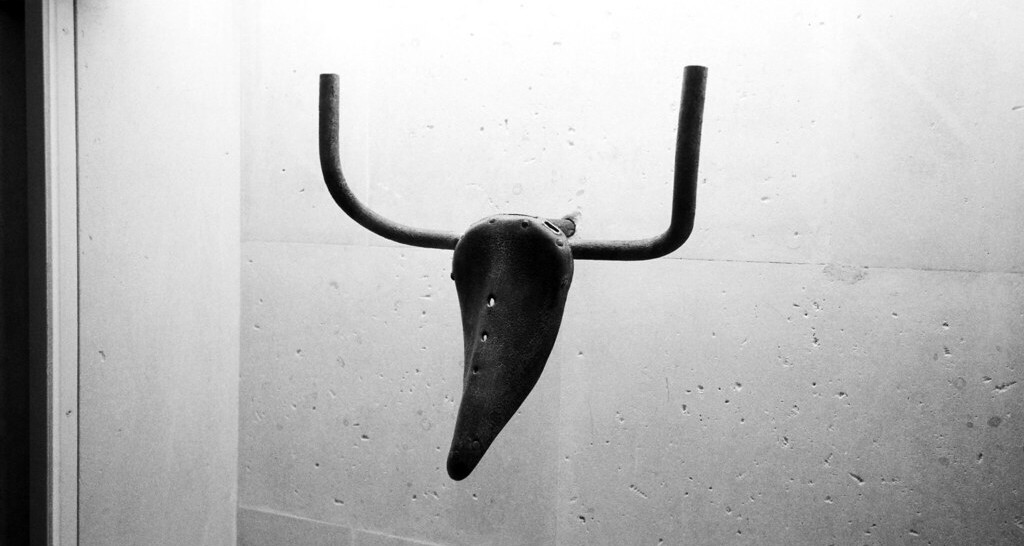An epic contest from the Annual Green Fair and South West Scythe Festival in Somerset, U.K., June 2010.
One commenter wrote, “Now we know why Death carries a Scythe, not a brushcutter.”
An epic contest from the Annual Green Fair and South West Scythe Festival in Somerset, U.K., June 2010.
One commenter wrote, “Now we know why Death carries a Scythe, not a brushcutter.”

One day his inventive eye fell on an old bicycle saddle and handlebars. Placing the handlebars at the back of the saddle in an upright position he created a bull’s head with horns. The illusion was striking and the virtuosity of the transformation conferred a kind of noisy notoriety on this Tête de taureau. When it was exhibited after the Liberation Picasso looked at it with an amused air. ‘A metamorphosis has taken place,’ he said to André Warnod, ‘but now I would like another metamorphosis to occur in the opposite direction. Suppose my bull’s head was thrown on the rubbish heap and one day a man came along and said to himself: “There’s something I could use as handlebars for my bicycle.” Then a double metamorphosis would have been achieved.’
— A. Vallentin, Picasso, 1963
This verse is known as “Lord Macaulay’s Last Riddle.” Lord Macaulay was Thomas Babington Macaulay (1800-1859), though his authorship of the riddle is uncertain. What’s the answer?
Let us look at it quite closely,
‘Tis a very ugly word,
And one that makes one shudder
Whenever it is heard.
It mayn’t be very wicked;
It must be always bad,
And speaks of sin and suffering
Enough to make one mad.
They say it is a compound word,
And that is very true;
And then they decompose it,
Which, of course, they’re free to do.
If, of the dozen letters
We take off the first three,
We have the nine remaining
As sad as they can be;
For, though it seems to make it less,
In fact it makes it more,
For it takes the brute creation in,
Which was left out before.
Let’s see if we can mend it —
It’s possible we may,
If only we divide it
In some new-fashioned way.
Instead of three and nine, then,
Let’s make it four and eight;
You’ll say it makes no difference,
At least not very great;
But only see the consequence!
That’s all that need be done
To change this mass of sadness
To unmitigated fun.
It clears off swords and pistols
Revolvers, bowie-knives,
And all the horrid weapons
By which men lose their lives;
It wakens holier voices —
And now joyfully is heard
The native sound of gladness
Compressed into one word!
Yes! Four and eight, my friends!
Let that be yours and mine,
Though all the hosts of demons
Rejoice in three and nine.
Swedish graffiti artist Daniel Fahlström makes trompe l’oeil murals of mylar balloon letters — there are no balloons, just the two-dimensional painted surface, but the effect is stunningly deceiving.
“I’ve seen a lot of reactions from people, and the funniest one was when this old lady that wasn’t wearing her glasses, she was trying to go up and touch the balloons,” he told Business Insider. “That’s good if they think that’s real balloons. That’s my mission, to make them believe that.”
Number eight cells:

Now suppose we want to color each cell red or blue such that no three cells are in arithmetic progression — for example, we don’t want cells 1, 2, and 3 to be the same color, or 4, 6, and 8. With eight cells it’s possible to accomplish this:

But if we want to add a ninth cell we can’t avoid an arithmetic progression: If the ninth cell is blue then cells 1, 5, and 9 are evenly spaced, and if it’s red then cells 3, 6, and 9 are. Dutch mathematician B.L. van der Waerden found that there’s always such a limit: For any given positive integers r and k, there’s some number N such that if the integers {1, 2, …, N} are colored, each with one of r different colors, then there will be at least k integers in arithmetic progression whose elements are of the same color. Determining what this limit is (in this example it’s 9) is an open problem.
(Bonus: Alexej Kanel-Belov found this pretty theorem concerning divisibility of integer sums within an infinite grid — Martin J. Erickson, in Beautiful Mathematics, calls it a two-dimensional version of van der Waerden’s theorem.)

In June 1940, German forces took the Channel Islands, a small British dependency off the coast of France. They expected the occupation to go easily, but they hadn’t reckoned on the island of Sark, ruled by an iron-willed noblewoman with a disdain for Nazis. In this week’s episode of the Futility Closet podcast we’ll tell the story of Sibyl Hathaway and her indomitable stand against the Germans.
We’ll also overtake an earthquake and puzzle over an inscrutable water pipe.
Politician and amateur theologian John Asgill raised some eyebrows in 1700 — he claimed that Christians needn’t die to enter heaven. In his resurrection, Christ had broken the Law of Death, and God had sent a chariot of heaven to collect him directly. The faithful could simply follow him — dying was no longer necessary:
I shall not go hence by returning unto the Dust … But that I shall make my Exit by way of Translation, which I claim as a dignity belonging to that Degree in the Science of Eternal Life, of which I profess my self a graduat, according to the true intent and meaning of the covenant of Eternal Life revealed in the Scriptures. And if after this, I die like other Men, I declare my self to die of no religion.
The Irish House of Commons expelled him for blasphemy, and he died, distinctly earthbound, in a debtors’ prison in 1738. Daniel Defoe wrote, “When Men Pore upon the Sacred Mysteries of Religion with the Mathematical Engines of Reason, they make such incoherent stuff of it, as would make one pity them.”
(From Philip C. Almond, Afterlife: A History of Life After Death, 2016.)
A campus legend collected by American folklorist Simon J. Bronner:
One weekend this past winter, four college students went away for a weekend while midterms were going on. However, it was not until late Sunday night that the students realized that they all had a Philosophy exam the next morning at 8 AM. This proved to be most unfortunate as none had even cracked a book for the course, and even if they had studied they would never be able to make it back to school in time for the exam. So, one of the students called their professor and told him that they had gotten a very bad flat tire, where the rim was bent. The mechanic said that he would not be able to repair it until Monday afternoon. Well, the professor was very understanding and told them to take their time getting back and to call him when they were on campus again. Well, the students thought this was great. They came leisurely back on campus Monday afternoon and called the professor. He said they could take the exam the next morning in the auditorium. Come the next morning, all four students arrived in the auditorium and were seated in each of the four corners of the room. The professor then proceeded to give the following instructions: ‘I know that you have all had a chance to talk with the other students in this class in order to find out what was on the exam. Well, fear not, because this is a very different exam. In fact, you will be very happy to know that there is only one very simple question on this exam. Are you ready to begin?’ All of the students nod. ‘Okay, you will have ninety minutes. The question is: Which tire?’
(From his Campus Traditions, 2012.)
A stick is broken at random into 3 pieces. It is possible to put them together into the shape of a triangle provided the length of the longest piece is less than the sum of the other 2 pieces; that is, provided the length of the longest piece is less than half the length of the stick. But the probability that a fragment of a stick shall be half the original length of the stick is 1/2. Hence the probability that a triangle can be constructed out of the 3 pieces into which the stick is broken is 1/2.
— Samuel Isaac Jones, Mathematical Wrinkles, 1912

In contemporary secretary schools, training emphasizes the inhibition of reading for meaning while typing, on the assumption that such reading will hinder high-speed performance. Some support for this assumption derives from the introspections of champion speed typists, who report that they seldom recall the meaning from the source material incidentally.
— William E. Cooper, Cognitive Aspects of Skilled Typewriting, 2012
We don’t even know the keyboard. A 2013 study at Vanderbilt asked 100 subjects to take a short typing test; they were then shown a blank QWERTY keyboard and given 80 seconds to label the keys. On average they typed at 72 words per minute with 94 percent accuracy but could correctly label only 15 letters on a blank keyboard.
“This demonstrates that we’re capable of doing extremely complicated things without knowing explicitly what we are doing,” said graduate student Kristy Snyder.
It had formerly been believed that typing starts as a conscious process that becomes unconscious with repetition. But it appears that typists never memorize the key locations in the first place.
“It appears that not only don’t we know much about what we are doing, but we can’t know it because we don’t consciously learn how to do it in the first place,” said psychologist Gordon Logan.
(Kristy M. Snyder et al., “What Skilled Typists Don’t Know About the QWERTY Keyboard,” Attention, Perception, & Psychophysics 76:1 [January 2014], 162-171.)